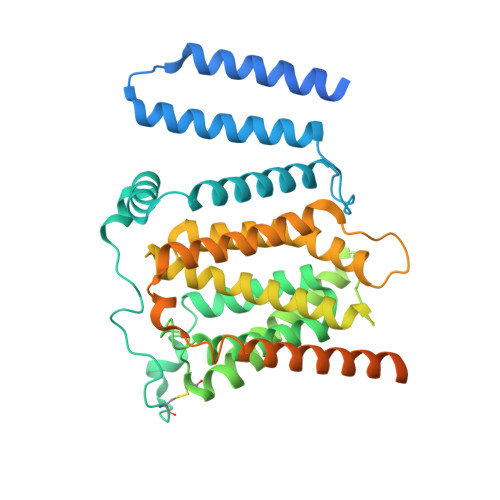Molecular insights into human phosphatidylserine synthase 1 reveal its inhibition promotes LDL uptake.
Long, T., Li, D., Vale, G., Jiang, Y., Schmiege, P., Yang, Z.J., McDonald, J.G., Li, X.(2024) Cell 187: 5665-5678.e18
- PubMed: 39208797
- DOI: https://doi.org/10.1016/j.cell.2024.08.004
- Primary Citation of Related Structures:
9B4E, 9B4F, 9B4G - PubMed Abstract:
In mammalian cells, two phosphatidylserine (PS) synthases drive PS synthesis. Gain-of-function mutations in the Ptdss1 gene lead to heightened PS production, causing Lenz-Majewski syndrome (LMS). Recently, pharmacological inhibition of PSS1 has been shown to suppress tumorigenesis. Here, we report the cryo-EM structures of wild-type human PSS1 (PSS1 WT ), the LMS-causing Pro269Ser mutant (PSS1 P269S ), and PSS1 WT in complex with its inhibitor DS55980254. PSS1 contains 10 transmembrane helices (TMs), with TMs 4-8 forming a catalytic core in the luminal leaflet. These structures revealed a working mechanism of PSS1 akin to the postulated mechanisms of the membrane-bound O-acyltransferase family. Additionally, we showed that both PS and DS55980254 can allosterically inhibit PSS1 and that inhibition by DS55980254 activates the SREBP pathways, thus enhancing the expression of LDL receptors and increasing cellular LDL uptake. This work uncovers a mechanism of mammalian PS synthesis and suggests that selective PSS1 inhibitors have the potential to lower blood cholesterol levels.
- Department of Molecular Genetics, University of Texas Southwestern Medical Center, Dallas, TX 75390, USA.
Organizational Affiliation:

















